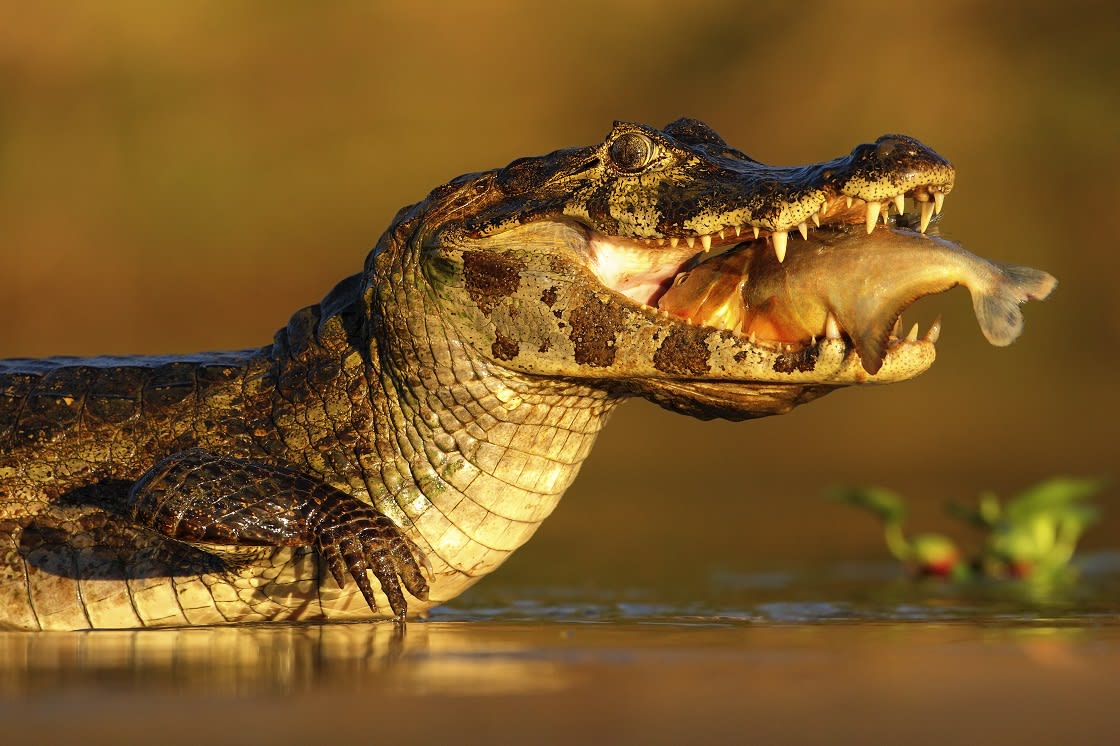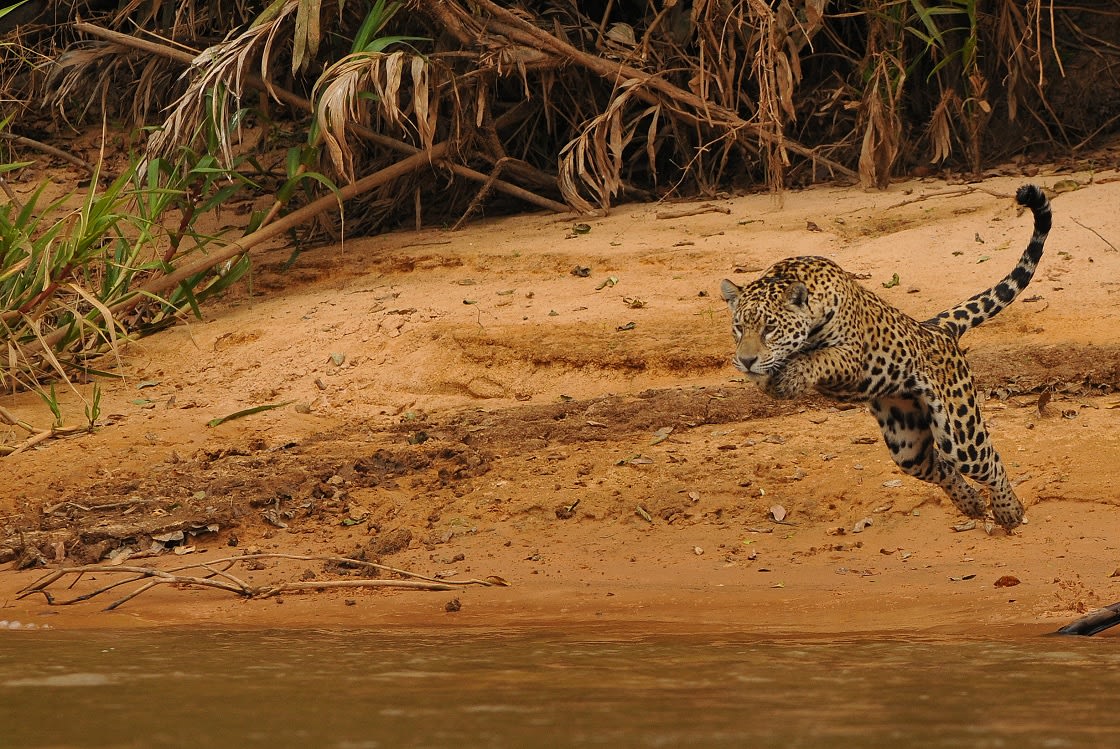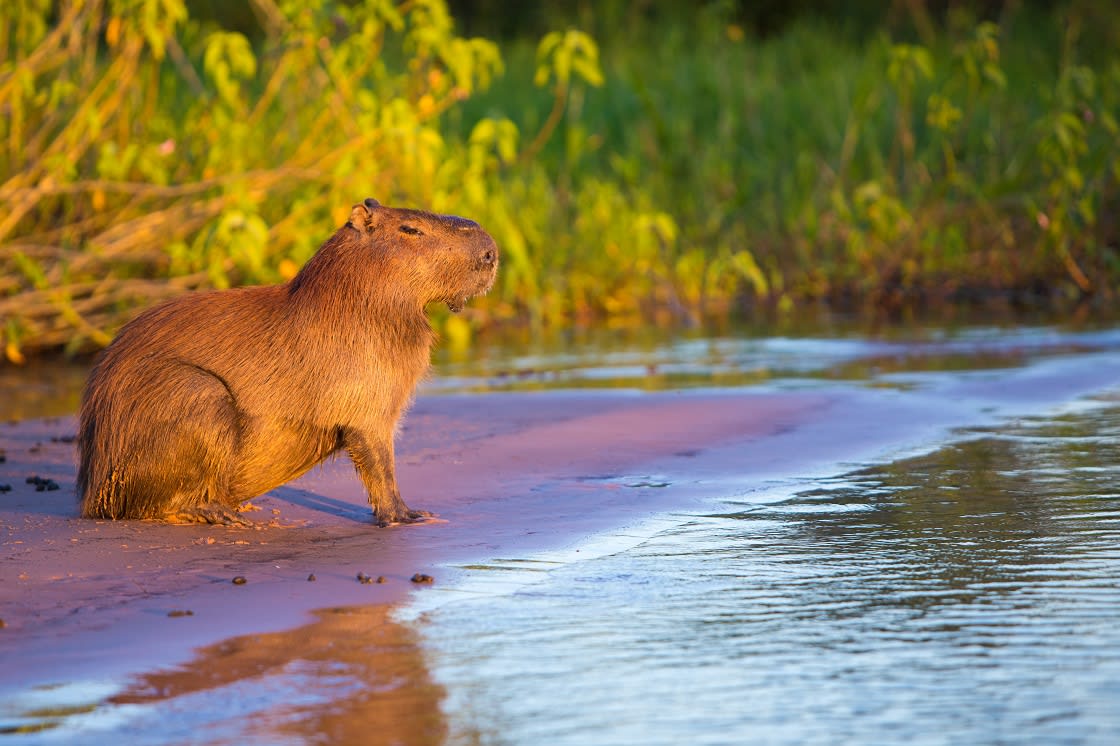
One of the largest, most pristine, and most biologically vibrant wetlands in the world, the Pantanal offers South America’s all-around best wildlife-viewing opportunities. The “Kingdom of Waters,” as it’s sometimes called, easily ranks among the best ecotourism destinations on the planet, and mixes the spectacular animal-watching and the mesmerizing, half-liquid landscapes with fascinating glimpses into a sustainable cattle-ranching culture, which plays out amid all this watery wildness.
In this post, we’ll cover some of the basics of where (and when) to find some of the Pantanal’s iconic wildlife, with the caveat that you’re just about guaranteed cool critter sightings anywhere you visit the Pantanal, and any time of year.

Yacare Caiman With Fish
The Pantanal’s location—a broad, flat basin mostly in western Brazil but spilling into southeastern Bolivia and northeastern Paraguay—puts it essentially smack dab in the heart of South America. This great wetland-savanna—which, believe it or not, was an arid desert not all that long ago in the geological past—comes anchored by the upper Paraguay River and mainly its left-bank tributaries, among them the Cuiabá, the San Lourenco-Itiquari, the Taquari, and the Miranda. Covering between 54,000 and 81,000 square miles, the Pantanal is arguably the largest tropical wetland on the planet—some 10 times the size of the Florida Everglades—and one of the biggest freshwater wetlands of any kind.
This floodplain complex overspills with water during the rainy season, inundating some 80 percent of the land in a typical year as the sluggish, swollen alluvial flow expands across the mostly flat lowlands. That annual flooding nutrifies the soil and helps dictate the layout of the Pantanal’s ecosystems, which range from extensive oxbow lakes, marshes, and lagoons to gallery forests, shrub, and tree savannas (cerrado), grasslands, and deciduous, semideciduous, and evergreen woodland.
The name “Pantanal,” incidentally, derives from pantano, a Portuguese word for swamp, marsh, or an otherwise soggy spot.

Jaguar In Action
By far the majority of the well-developed Pantanal tourism takes place in Brazil, though more adventurous visitors might consider the less-trammeled Paraguayan Pantanal or the barely commercialized Bolivian Pantanal.
Within the Brazilian Pantanal, you’ll find more lodges in Matto Grosso than in Matto Grosso du Sol and thus more options for covering some ground; in the southern part of the Brazilian Pantanal, you’re better bet is focusing on one or two main areas based on your accommodations. Two main dirt thoroughfares provide vehicle access during the dry season: the Transpantaneria in the north, which cuts across a variety of habitats to reach Porto Jofre, and the Estrada Parque in the south.
You can see wildlife in the Pantanal all year-round, but from both the visitor-access perspective and wildlife-spectacle perspectives, the dry season is the all-around best time. As we’ll get to, this is the best window for seeing jaguars, and it’s also when you can enjoy views of those huge jabiru storks that breed here during the dry season, feeding their nestlings with fish nabbed in drying waterholes and refuges in the muck. Rookeries of many other wading birds, including herons, egrets, wood storks, and roseate spoonbills, are also an unforgettable dry-season phenomenon. Caimans and other aquatic critters are more densely congregated with the more limited water, and more roadways are dry and drivable.
The wet season presents some stunning flood-scape vistas and its own tremendous wildlife activity—including some higher mammalian densities on the relatively scarce dry ground—but access is much more limited and basically restricted to boats and airplanes, and furthermore, the heat and biting insects are a bit more intense.
By far the best place to see jaguars in the Pantanal (and therefore the world) is Matto Grosso, and specifically in the vicinity of Porto Jofre along the Cuiabá River. Here jaguars commonly lounge along the riverbanks and are fairly accustomed to the presence of people. In most parts of the jaguar’s extensive range in Mexico, Central America, and South America, glimpsing one is a tall order, whether due to low densities, dense rainforest or jungle vegetation, or both. But along the Cuiabá in the Pantanal, you’ve got a really solid chance of landing a jaguar sighting, particularly from the middle to the late dry season.
Jaguars are sometimes also encountered along the Transpantaneria and along the Miranda River in Matto Grosso du Sol.
The Cuiabá and its tributaries also offer decent odds of seeing giant otters. Meanwhile, the savannas of Matto Grosso du Sol set you up for possibly spotting such cerrado beasts as giant anteaters, maned wolves, and pampas deer.
Both of the Brazilian Pantanal states, though, offer ample opportunities to see a lot of signature species such as caimans, hyacinth macaws, and jabiru storks (which are widespread in the Pantanal but especially abundant in certain hotspots such as the Cuiabá and the Miranda). Tapirs and capybara are often readily seen close to the Pantanal’s main tourist lodges.

Wild Capybara
In addition to various private reserves—most of the Pantanal is privately owned—the following government-protected areas offer prime wildlife-viewing:
Among the numerous Pantanal-area lodges and other accommodations that provide access to these protected spots and private reserves—and which often host their own wildlife-viewing opportunities—are the Caiman Ecological Refuge, the Araras Eco Lodge, and SouthWild Jaguar Suites. The well-known Brazilian ecotourism hub of Bonito can serve as a springboard for explorations of the southern Pantanal as well as plenty of other relatively nearby ecological hotspots, not least the incredible Buraco Das Araras (Sinkhole of the Macaws), commonly lumped into Pantanal tours.
For a first-time visit to the Pantanal, it’s hard to beat the Cuiabá River area in the dry season—but those who return again and again to the Kingdom of Waters, in each of its seasons and across its grand breadth, will get to know this one-of-a-kind place and its flashy fauna all the deeper.
While Rainforest Cruises aim to provide accurate and up-to-date information, we make no representations as to the accuracy or completeness of any information herein or found by following any link on this site. Rainforest Cruises cannot and will not accept responsibility for any omissions or inaccuracies, or for any consequences arising therefrom, including any losses, injuries, or damages resulting from the display or use of this information.




